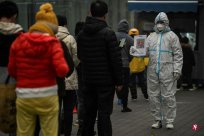The comprehensive group of the China State Council ’s joint prevention and control mechanism formulates four documents, which specify the response measures in detail in terms of nucleic acid testing and risk zones. The new plan stipulates that the area where there is no epidemic may not expand the scope of the detection of nucleic acid. Generally, it is not generally not.Carnivor nucleic acid testing according to the administrative area; if individual cases have been judged to have no risk of community communication, regional nucleic acid testing may not be performed.
The website of the China National Health and Health Commission's website (November 21) released the implementation method of the new coronary pneumonia epidemic in the new coronary pneumonia epidemic in the comprehensive control mechanism of the State CouncilPlan new crown pneumonia epidemic home isolation medical observation guideline new crown pneumonia epidemic home health monitoring guide.
Among them, the implementation measures for the testing of nucleic acid prevention and control nucleic acid in the new coronary pneumonia are listed. In areas where there is no epidemic situation, risk -up positions and key personnel are strictly detected in accordance with the scope determined by the ninth edition prevention and control plan.The scope of nucleic acid detection generally does not conduct all -employed nucleic acid testing according to the administrative area.
The test for cross -regional mobilization personnel In accordance with the principle of "voluntary, free, ingredients, and unlimited flow", at the airport, railway station, long -distance passenger station, highway provincial boundary service area, port, etc.Establish nucleic acid sample points to provide "land inspection" services for cross -provincial mobile personnel.
Passengers need to detect negative proof of 48 hours of kernel acidic acid proof of aircraft, high -speed rail, train, cross -provincial long -distance passenger cars, cross -provincial passenger ships and other transportation.Personnel to leave the land border port must hold a 48 -hour kernel to detect negative proof.Staying in hotels and people entering the tourist attractions must check the health code and 72 -hour kernel test negative proof.
In terms of regional nucleic acid testing, the new scheme stipulates that on the basis of epidemiological survey, factors such as the regional population size, whether the source of infection sources occur in the epidemic occurredComprehensive research and judgment, according to the risk size, according to the principle of classification, determine the scope, frequency and sequence of the detection crowd.
For individual cases and asymptomatic infections, the risk of dissemination of residence, working place, and activity area is relatively low. Those who are closely contacted have been controlled in a timely manner. After judging the risk of community dissemination, regional nucleic acid testing may not be carried out.
In the provincial capital cities and cities above tens of millions of population, after the epidemic, after the underwriting and judgment, the dissemination chain is unclear, the risk places and risk personnel are large, the risk personnel liquidity is large, the epidemic is spreading risks when there is diffusion risk.The area where the epidemic is located once a day of nucleic acid testing. After three consecutive nucleic acid testing without social infection, a full -work nucleic acid test is carried out for three days. Those who have no social infection can stop all nucleic acid testing.
Other areas with frequent activities and long stay in the infected persons can be determined based on the underwriting research and judgment, and a certain area will be carried out to conduct a total nucleic acid test.In principle, a whole nuclear acid test is carried out once a day. Those who have no social infection without social infection for three consecutive nucleic acid tests can stop the detection of all staff.
In addition, according to the newly released new crown pneumonia epidemic risk zone delineation and control plan, once a local epidemic occurs, the county (city, district, flag) of those who are not infected as soon as possible should be accurately divided into as soon as possible.Classified management measures are implemented with two types of risk areas: high -risk areas and low -risk areas.
If individual cases and asymptomatic infections are low in dissemination of the residence, working place, and activity area. Those who are closely contacted have been managed and controlled in a timely manner.Essence
In terms of high -risk areas, in principle, the place where the infected person lives, as well as areas and regions such as frequent activity and high risk of epidemic dissemination, and are classified as high -risk areas.
According to the new plan, the high -risk zone is generally determined by units and buildings.In the case of inaccurate risk of epidemic dissemination or extensive community communication, the scope of high -risk areas can be appropriately expanded.
The high -risk areas need to be closed control measures, and during the period, "not leaving the house and on -site service".During the seal -control period, a new infected person is found by the local joint prevention and control mechanism organization to conduct risk research and judgment. In accordance with the requirements of the "one district, one policy", the original seal control area can be extended all or partially.
If new infections are not found in the high risk zone for five consecutive days, and all personnel in the risk area in the fifth day of the risk area, all personnel complete a round of nucleic acid screening are negative and reduced to low risk areas.High -risk areas that meet the unpacking conditions should be unblock in time.



